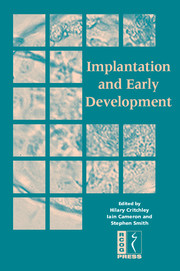Book contents
- Frontmatter
- Contents
- DECLARATION OF INTEREST
- Participants
- Preface
- SECTION 1 PREPARATION FOR IMPLANTATION – THE UTERINE ENVIRONMENT
- 1 Endocrine and paracrine signalling in the human endometrium: potential role for for the prostanoid family in implantation
- 2 Immunology of implantation
- 3 Progestin-indusced decidualisation promotes human endometrial haemostasis and vascular stabulity
- 4 Adhesion molecules and implantation
- 5 Vascular growth and modelling in the endometrium
- 6 Tissue remodelling the fetal-maternal interface: the regulation of matrix metalloproteinase 9 transcription
- 7 Embryo interactions in human implantation
- 8 Experimental models of implantation of the human embryo: reconstructing the endometrial–embryo dialogue in vitro
- SECTION 2 THE EMBRYO
- SECTION 3 LESSONS FROM ANIMAL MODELS (TRANSGENICS) AND NOVEL TECHNOLOGIES
- SECTION 4 CLINICAL SEQUELAE
- SECTION 5 CONSENSUS VIEWS
- Index
6 - Tissue remodelling the fetal-maternal interface: the regulation of matrix metalloproteinase 9 transcription
from SECTION 1 - PREPARATION FOR IMPLANTATION – THE UTERINE ENVIRONMENT
Published online by Cambridge University Press: 05 June 2014
- Frontmatter
- Contents
- DECLARATION OF INTEREST
- Participants
- Preface
- SECTION 1 PREPARATION FOR IMPLANTATION – THE UTERINE ENVIRONMENT
- 1 Endocrine and paracrine signalling in the human endometrium: potential role for for the prostanoid family in implantation
- 2 Immunology of implantation
- 3 Progestin-indusced decidualisation promotes human endometrial haemostasis and vascular stabulity
- 4 Adhesion molecules and implantation
- 5 Vascular growth and modelling in the endometrium
- 6 Tissue remodelling the fetal-maternal interface: the regulation of matrix metalloproteinase 9 transcription
- 7 Embryo interactions in human implantation
- 8 Experimental models of implantation of the human embryo: reconstructing the endometrial–embryo dialogue in vitro
- SECTION 2 THE EMBRYO
- SECTION 3 LESSONS FROM ANIMAL MODELS (TRANSGENICS) AND NOVEL TECHNOLOGIES
- SECTION 4 CLINICAL SEQUELAE
- SECTION 5 CONSENSUS VIEWS
- Index
Summary
Introduction
As life moved out of the oceans, new reproductive strategies developed to account for the loss of nutrients and oxygen normally provided by the water environment. Despite the fact that many examples of viviparity exist in invertebrates, fish, amphibians and reptiles, placentation is a relatively new acquisition in evolution. The establishment of an intimate trophic connection between mother and embryo is a characteristic of mammals. Implantation and the ensuing placentation are thus new strategies in reproduction, which allow the development of a small number of fetuses in the protective maternal organism. As the mammals evolved from small rodent-like creatures with short gestational periods to larger animals with prolonged gestations, the placenta had to adapt to the increasing needs of the growing fetus.
Orchestrating the blastocyst—endometrial summit requires perfect synchronisation between embryonic development and endometrial maturation. This synchronisation does not only involve the embryo and the endometrium but also the maternal pituitary and the ovary. As a result of ovarian oestradiol and progesterone secretions, the endometrium proliferates and differentiates. During the mid-luteal phase (days 22—24 of a 28-day cycle) decidualisation starts around the endometrial spiral arteries and extends to the whole endometrium within a few days. The endometrial extracellular matrix (ECM) becomes distended because water is attracted, possibly owing to the decidual secretion of hygroscopic molecules such as heparan sulphate proteoglycans.
Keywords
- Type
- Chapter
- Information
- Implantation and Early Development , pp. 70 - 78Publisher: Cambridge University PressPrint publication year: 2005

